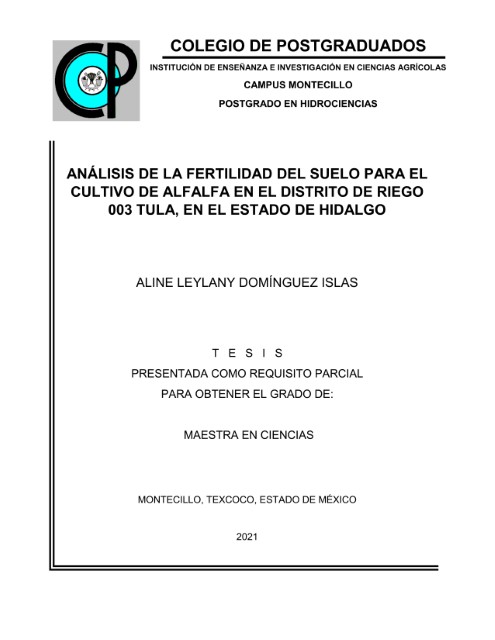
Fecha: 2021-10
ALINE LEYLANY DOMÍNGUEZ ISLAS, M. C. Colegio de Postgraduados, 2021
RESUMEN
En el presente trabajo de investigación se evaluaron las
concentraciones de P para conocer si se cumple con la demanda nutrimental de P
para el cultivo de alfalfa (Medicago sativa). También se evaluó el contenido de
Cd, Pb, Cr y As en suelo y en biomasa vegetal de alfalfa para saber si supera
los límites de tolerancia establecidos por Holanda para elementos contaminantes.
Se hizo un muestreo aleatorio en donde se tomaron 35 muestras de suelo y tejido
vegetal en parcelas del DR-003 Tula. Se realizó la caracterización
físico-química de suelo mediante la determinación de densidad aparente, textura,
materia orgánica, pH, CE, bases intercambiables y algunos nutrientes usando la
metodología descrita en la NOM-021-RECNAT-2000. Los análisis se realizaron en el
laboratorio de Laboratorio de Ciencias Ambientales del COLMERN, donde se
determinaron las concentraciones de P con el método de Olsen mediante un
espectrofotómetro Cintra 202, y para las concentraciones de: Cd, Cr, Pb y As se
realizó digestión en un sistema cerrado utilizando un horno de microondas
Multiwave PRO Anton-Para y se obtuvo la lectura con un ICP-OES
(espectrofotómetro de plasma óptico acoplado inductivamente) modelo HORIBA
ULTIMA. Se encontró que el contenido de P en el suelo y biomasa vegetal es
óptimo para el desarrollo de la alfalfa, las concentraciones de Cr, Pb y As en
suelo se encuentran dentro de los límites permisibles establecidos por Holanda,
mientras que el Cd supera el 0.80 mg/kg con una concentración máxima de 1.4 mg/kg.
El Cd y el Cr se encuentran en altas concentraciones en la biomasa vegetal con
valores hasta 7.0 mg/kg y 7.4 mg/kg respectivamente.
Palabras clave: biomasa vegetal, elementos contaminantes, fósforo, suelos, riego
con aguas negras.
SOIL FERTILITY ANALYSIS FOR ALFALFA CULTIVATION IN THE IRRIGATION
DISTRICT 003 TULA, STATE OF HIDALGO.
ABSTRACT
In the present research work P concentrations were evaluated to know if the nutritional demand of P for the cultivation of alfalfa (Medicago sativa), as well as the content of Cd, Pb, Cr and As in soil and in alfalfa plant biomass to find out if it exceeds the tolerance limits established by the Netherlands for polluting elements. A random sampling was carried out, where 35 soil and plant tissue samples were taken in plots of DR-003 Tula, the physical and chemical characterization of the soil was carried out by determining apparent density, texture, organic matter, pH, EC, interchangeable bases and some other nutrients using the methodology described in NOM-021-RECNAT-2000. The analyzes were carried out in the Laboratory of Environmental Sciences of COLMERN, where P concentrations were determined by the Olsen method using a Cintra 202 spectrophotometer, and for Cd, Cr, Pb and As concentrations a digestion was carried out in a closed system using a Multiwave PRO Anton-Para microwave oven and the reading was obtained with an ICP-OES (Inductively Coupled Optical Plasma Spectrophotometer) model HORIBA ULTIMA. It was found that P content in the soil and plant biomass is optimal for the development of alfalfa, the concentrations of Cr, Pb and As in soil are within the permissible limits established by the Netherlands, while Cd exceeds 0.80 mg / kg with a maximum concentration of 1.4 mg / kg. Cd and Cr are found in higher concentrations in plant biomass with values up to 7.0 mg / kg and 7.4 mg / kg respectively.
Keywords: plant biomass, polluting elements, phosphorus, soils, sewage irrigation.